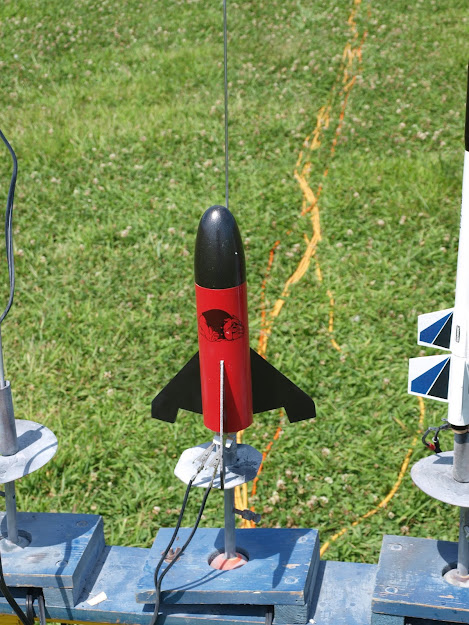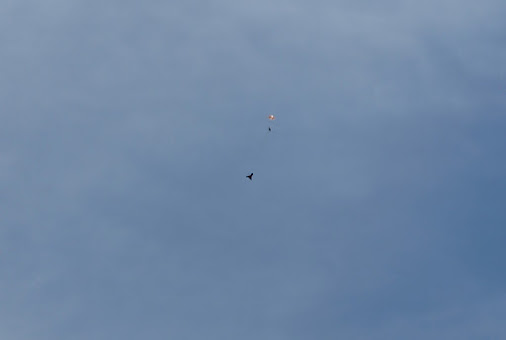I was hoping that 2015 would be different than the previous disappointing flying season, and I was pretty pumped about how it started. Then May hit. I had one good day, then the graduation parties started, or the rain submerged things, or I had to drive my daughter's car to California. By August, I was hurting.
So, here we are nearing the end of summer and I have the opportunity to spend a full day, 10-5, on one of the friendliest flying fields I've ever flown on. What do I do?
I oversleep.
I immediately went into crisis mode, which could have been avoided had I gone through with my "pre flight checklist". This was something I thought might lessen the launch day confusion, letting me pre-pack everything and have it ready to go the night before. That way I could wake up, shower, eat breakfast, and pack the car without stressing about forgetting anything. Sounds useful,eh? Yeah, maybe next time.
So, this time I showered, ate, packed the car and hit the road. I thought I'd done well until twenty miles up the road when I realized that I'd forgotten the Tupperware container with my composite motors in it. No Leviathan flight. Again. I pressed on. I had a blog to update.
But enough about my issues. Let's get on to the rockets. Despite being well rested, I was not happy. That lasted until I saw the first rocket heading skyward as I drove up. I watched a rack and got some photos, then prepped my first victim. The first flight of the day for me was an Estes Star Wars Star Destroyer that I rescued off of Ebay a few years back. It was in rough shape, but had flown previously, which is what made me decide to bid on it and try to rebuild it.
It was missing the engine hook, so I taped in a D12-3, which is the only suggested motor. Several comments were made about the supposed unreliability of the Star Destroyer, but since this one had a previous flight history, I wasn't terribly concerned. I did call a heads-up flight. I needn't have worried.
I should explain about the dog. Daisy, I believe, is her name. She enjoys being up at the pad barking encouragement with each rack of flights. It's kind of funny. Once. I tend to be more of a traditionalist who finds beauty in the sounds of the launch. I've got a dog on the hill behind me who doesn't need rockets as an excuse to bark for hours on end, and I go to the field to get away from that. As for the Star Destroyer, the D12-3 was more than adequate to get the pig off the pad. It left without so much as a wiggle, which was good to see. I was surprised at the height of the flight, which looked to top out above 300'. Ejection came just as it tipped and the whole mess did a free-fall for a few seconds before the chute popped.
Recovery was perfect. The walk was short. The Star Destroyer will live to fly another day, and made me glad that the first flight wasn't at B6-4 Field as planned. That would not have turned out well.
The next victim would be the FRW Bulldog Low, a recently completed SPEV-style home-brew bird. This one was 24mm powered, simply because I had a fin can, nose cone, and some 5070 centering rings sitting around with nothing better to do. I chose a D12-5 as the first flight motor because it should have been a very stable bird with a big field to stretch its legs on. It was a great choice.
I was rewarded with a dead straight flight to about 800', exactly what I'd hoped for. (Please keep in mind that I just estimate, and occasionally hope, any distances expressed here.) Suffice to say it was a nice flight and perfect recovery just beyond the pads.
I'd spent the last few days prior to the launch finishing two MRC kits, the Wildfire and the XR-20. The Wildfire had previously flown naked at B6-4 Field, but I brought both along in their new duds, hoping to allow both of them the chance to stretch out on a C6-5. Always looking to put a flight on an unflown kit, I went with the XR-20 first.
Looks pretty good, eh? Just like the catalog picture? Well that's solely because I took the time to scan the stickless sticker decals and paint it up just like the face card. All in all, not bad looking birds, but not without faults. They have the thinnest tubes I've ever encountered, truly a step up from typing paper, but a major step down from the industry standard. The XR-20 was the first of the kits I completed and it got the full finishing treatment; primer, Fill & Finish, sanding. It almost didn't survive the sanding. The tubes were so thin that they threatened to fold under the slightest pressure. There's a reason you don't see many of these at the pads.
Like I said, I wanted to stretch them out, so the XR-20 got the C6-5 treatment. The flight itself was impressive. Great altitude, with only the slightest arc to the left of the pad. It topped out around the same height as the Bulldog Low and popped the chute just as it tipped. Recovery occurred within 100' of the pads, and I have to admit a grudging respect for the performance. When I picked it up the good feelings were short lived. I noticed the paint and decals had bubbled just over the engine mount. I touched the area and almost put my finger into the body cavity of the rocket. The ejection charge had apparently burned away everything but the glassine layer, paint and decal. It might last one more flight. Pretty sad.
For the fourth flight of the day I went with a previously flown favorite, the Centuri USS America that I'd cloned with Moldin' Oldies and Semroc parts several years back.
A CATO victim on its first flight, it had nonetheless impressed with its performance on subsequent flights. I had a few moments of confusion while deciding on an engine for the flight. I knew that it was a 24mm bird, but had forgotten that I made it capable of handling the Estes E9. Luckily I'd not forgotten my stash of E9-4s.
As usual, the flight was impressive. It left the pad arcing to the left and behind the pads slightly. That was wide open country, though. The E9-4 seemed to burn forever and took the USS America to a respectable height somewhere near 1000'. Very cool. Recovery occurred on the wide open prairie, pad left.
Lately I've been interested in scaling classic kits up and down, something like what I've done with the Red Max family. Next to the Max, one of my favorite oldies is the Estes Wizard, a rocket I have a long history with dating back to 1979. The Wizard was my NARTREK Bronze bird, and I'd previously flown a BT-80 version at the NARAM in Lebanon, but recently I'd decided to see if I could fill out the rest of the body tubes in the series.
The BT-5 Mini Wizard is my most recent, with a BT-50 lacking only a decal at home. The Mini would fly on this day on an A3-4T and employ nose blow recovery. Big field, lots of eyes, no way I could lose this one, right? Not so much. The Mini Wizard left the pad just the way my first one did on the C6-7 I flew it on in 1979. That one left me standing with my mouth hanging open. This one came close. We all saw where it headed, and saw the puff of tracking smoke, but the seeing ended there. I scanned the horizon in front of the pads, sure that I'd see it land in that area. I saw NU-THINK! Now I know why those original kits had those nice orange streamers. They didn't slow things down much, but they sure helped with visibility. I looked for fifteen minutes and came up empty, but Lee Berry found it on the way back from retrieving his own bird. Next flight gets a streamer.
My next flight would be another tried and true blast from the past, the Centuri Taurus I'd cloned with resin parts from Moldin' Oldies a few years back. This had previously been a 24mm bird, but I decided to make it a more traditional 18mm bird when I dusted it off recently.
The C6-5 flight was letter perfect, topping out around the 750' mark. It recovered in the field pad left and I anticipated nothing odd when I picked it up, only to find that the resin reducer had snapped. I'm going to try to epoxy it, but it may be a shelf queen from this point onward.
My last flight of the day would be the Estes Raven I'd recently completed. I bought this originally to scavenge the nose cone for cloning purposes, but was inspired to build the rocket after seeing Leo Nutz's Raven on his website. Very simple. Very cool. Very seldom seen.
This cone was originally part of the Estes Aerospace Plane that I cloned as a 24mm bird, and as such, I got a little crazy with the BBs and epoxy. I was afraid that the C6-5 might have trouble lifting the Raven, but I need not have worried. The flight was arrow straight to about 500' and recovered straight out from the pads. I retrieved it, helped another flyer look for his missing Mini Max, then headed in to find them striking the range. Yeah, I still had a couple of hours in me, but three was far better than the NOTHING I'd had since May, so I left happy. To Sonic for iced tea five minutes from the field. Can it get any better?





















I always enjoy the launch posts! Thanks for taking the time to write it up.
ReplyDeleteThat dog would have driven me nuts after the first few launches.
A large iced tea is always my drink of choice after a hot launch day.
I generally stop at the Sonic that is close to our field and get two of the Route 44 iced teas before I hit the field. I've had issues with getting overheated in the past few years and it really can spoil a four hour block of an otherwise great day. Luckily my kidneys are up to the challenge.
ReplyDelete